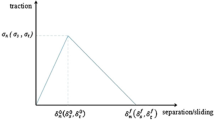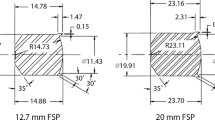Abstract
Present work deals with the nonlinear finite element analyses of ultra-high molecular weight polyethylene (UHMWPE). UHMWPE has been presented for ballistic design investigation of lightweight body armour using ANSYS-Workbench. The ballistic performance of UHMWPE has been compared with Kevlar/epoxy composite and alumina. The study is presented in terms of the ballistic limit of UHMWPE, Kevlar/epoxy, and alumina plate, the implication of obliquity (at 30°, 45°, and 60°), projectile shape (elliptical, conical, and spherical shape). The sequencing order of material layup for a bi-layer composite and ballistic performance of single-layered UHMWPE has been compared with the multi-layered plate. The parametric studies have been presented in the form of residual velocity, the ratio of energy transferred to impact velocity of the ballistic plate, and perforation rate for the single and multi-layered UHMWPE. The results of the numerical analyses of UHMWPE have been compared with the Kevlar/epoxy composite. It has been found that the armour system made of UHMWPE laminate composite resulted in a 40.6% weight reduction compared to Kevlar/epoxy configuration with a 17.3% higher ballistic limit.










Similar content being viewed by others
Abbreviations
- V 50 :
-
Ballistic limit velocity
- Et :
-
Energy transferred to plate by a projectile
- Ek :
-
Impact energy of the projectile
- V i :
-
The impact velocity of the projectile
- V r :
-
The residual velocity of the projectile
- m p :
-
Mass of the projectile
- m f :
-
Mass of the fractured part
- P :
-
The pressure at the impact point
- A 1, A 2, A 3, B o, T 1, T 2 :
-
Material constant for Mie-Gruneisen model
- \(\rho\) :
-
Density
- \(\mathop \rho \nolimits_{o}\) :
-
Zero pressure density
- \(\omega\) :
-
Internal energy per unit mass
- \(\mathop \sigma \nolimits_{u}^{*}\) :
-
Normalize intact strength
- \(\mathop \sigma \nolimits_{f}^{*}\) :
-
Normalized fractured strength
- \(\dot{\varepsilon }\) :
-
Normalized strain rate
- \({S \mathord{\left/ {\vphantom {S {\mathop S\nolimits_{h} }}} \right. \kern-\nulldelimiterspace} {\mathop S\nolimits_{h} }}\) :
-
Normalized strength at Hogonoit Elastic Limit
- \({P \mathord{\left/ {\vphantom {P {\mathop P\nolimits_{h} }}} \right. \kern-\nulldelimiterspace} {\mathop P\nolimits_{h} }}\) :
-
Normalized pressure at Hogonoit Elastic Limit
- D :
-
Scalar damage parameter (\(0 \le D \le 1\))
- G, B, H, N, M :
-
Material constants
- M m :
-
Mass of Kevlar/epoxy or alumina plate
- M U :
-
Mass of UHMWPE plate
- V K :
-
The ballistic limit for Kevlar/epoxy plate
- V U :
-
Ballistic limit of UHMWPE plate
- \(\mathop X\nolimits_{s1}^{1}\) and \(\mathop X\nolimits_{s2}^{2}\) :
-
Xi is the deformed position at the end of 1st surface and at the starting of 2nd surface, respectively
- \(\mathop T\nolimits_{s1}^{1}\) and \(\mathop T\nolimits_{s2}^{2}\) :
-
Ti is the traction force at the end of 1st surface and at the starting of 2nd surface respectively
- \(\lambda\) :
-
Lagrange multiplier
- \(\Gamma\) :
-
Domain of integral
References
Nayak N, Banerjee A and Sivaraman P 2013 Ballistic impact response of ceramic-faced aramid laminated composites against 7.62 mm armor-piercing projectiles. Def. Sci. J. 63(4): 369–375
Palta E, Fang H and Weggel D C 2018 Finite element analysis of the Advanced Combat Helmet under various ballistic impacts. Int. J. Impact Eng. 112: 125–143
Singh B B, Sukumar G, Senthil P P, Jena P K, Reddy P R S, Kumar K S, Madhu V and Reddy G M 2017 Future armour materials and technologies for combat platforms. Def. Sci. J. 67(4): 412–419
Joselin R and Wilson W J 2014 Investigation on impact strength properties of kevlar fabric using different shear thickening fluid composition. Def. Sci. J. 64(3): 236–243
Monteiro S N, Milanesi T L, Louro L H L, Lima É P, Braga F O, Gomes A V and Drelich J W 2016 Novel ballistic ramie fabric composite competing with KevlarTM fabric in multi-layered armor. Mater. Des. 96(15): 263–269
Goh W L, Zheng Y, Yuan J and Ng K W 2017 Effects of hardness of steel on ceramic armour module against long rod impact. Int. J. Impact Eng. 109: 419–426
Serjouei A, Gour G, Zhang X, Idapalapati G and Tan G E B 2016 On improving ballistic limit of bi-layer ceramic-metal armor. Int. J. Impact Eng. 105: 54–67
Elshenawy T, Seoud M A and Abdo G M 2019 Ballistic protection of military shelters from mortar fragmentation and blast effects using a multilayer structure. Def. Sci. J. 69(6): 538–544
Liu W, Chen Z, Chen Z, Cheng X, Wang Y, Chen X, Liu J, Li B and Wang S 2015 Influence of different back laminate layers on ballistic performance of ceramic composite armor. Mater. Des. 87(15): 421–427
Palta E, Gutowski M and Fang H 2018 A numerical study of steel and hybrid armor plates under ballistic impacts. Int. J. Solids Struct. 136–137: 279–294
Mohagheghian I, McShane G J and Stronge W J 2016 Impact perforation of polymer-metal laminates: projectile nose shape sensitivity. Int. J. Solids Struct. 88–89(15): 337–353
Ha-Minh C, Imad A, Kanit T and Boussu F 2013 Numerical analysis of a ballistic impact on textile fabric. Int. J. Mech. Sci. 69: 32–39
Mcwilliams B, Yu J, Pankow M and Yen C 2015 Ballistic impact behavior of woven ceramic fabric reinforced metal matrix composites. Int. J. Impact Eng. 86: 57–66
Hazzard M K, Hallett S, Curtis P T, Iannucci L and Trask R S 2016 Effect of fibre orientation on the low velocity impact response of thin dyneema® composite laminates. Int. J. Impact Eng. 100: 35–45
Zhang D, Sun Y, Chen L, Zhang S and Pan N 2014 Influence of fabric structure and thickness on the ballistic impact behavior of Ultrahigh molecular weight polyethylene composite laminate. Mater. Des. 54: 315–322
O’Masta M R, Crayton D H, Deshpande V S and Wadley H N G 2015 Mechanisms of penetration in polyethylene reinforced cross-ply laminates. Int. J. Impact Eng. 86: 249–264
Pundhir N, Goyal D, Singh P, Pathak H and Zafar S 2019 Numerical simulation of composite armor subjected to ballistic impact. Mater. Today Proc. 18(3): 696–703
Pundhir N, Arora G, Pathak H and Zafar S 2020 Ballistic Impact Response of HDPE/UHMWPE Polymer Composite. Biswal B, Sarkar B, Mahanta P Adv. Mech. Eng. Lect. Notes Mech. Eng. Springer, Singapore 245–255
Bogetti T A, Walter M, Staniszewski J and Cline J 2017 Interlaminar shear characterization of ultra-high molecular weight polyethylene (UHMWPE) composite laminates. Compos. Part A Appl. Sci. Manuf. 98: 105–115
Sapozhnikov S B, Kudryavtsev O A and Zhikharev M V 2015 Fragment ballistic performance of homogenous and hybrid thermoplastic composites. Int. J. Impact Eng. 81: 8–16
Chen X and Chu Y 2016 Failure mechanisms and engineering of ballistic materials, Advanced Fibrous Composite Materials for Ballistic Protection, Elsevier Ltd
Kulkarni S G, Gao X L, Horner S E, Zheng J Q and David N V 2013 Ballistic helmets - Their design, materials, and performance against traumatic brain injury. Compos. Struct. 101: 313–331
Bandaru A K, Chavan V V, Ahmad S, Alagirusamy R and Bhatnagar N 2016 Low velocity impact response of 2D and 3D Kevlar/polypropylene composites. Int. J. Impact Eng. 93: 136–143
García-Castillo S K, Sánchez-Sáez S and Barbero E 2012 Nondimensional analysis of ballistic impact on thin woven laminate plates. Int. J. Impact Eng. 39(1): 8–15
Sheikh A H, Bull P H and Kepler J A 2009 Behaviour of multiple composite plates subjected to ballistic impact. Compos. Sci. Technol. 69(6): 704–710
Ben-Dor G, Dubinsky A and Alperin T 2002 On the Lambert-Jonas approximation for ballistic impact. Mech. Res. Commun. 29(2–3): 137–139
Feli S and Asgari M R 2011 Finite element simulation of ceramic/composite armor under ballistic impact. Compos. Part B Eng. 42(4): 771–780
Krishnan K, Sockalingam S, Bansal S and Rajan S D 2010 Numerical simulation of ceramic composite armor subjected to ballistic impact. Compos. Part B Eng. 41(8): 583–593
Kumar S, Gupta D S, Singh I and Sharma A 2010 Behavior of kevlar/epoxy composite plates under ballistic impact. J. Reinf. Plast. Compos. 29(13): 2048–2064
GA G 2002 Implementation of the Johnson-Holmquist II (JH-2) constitutive model into DYNA3D. Army Research Laboratory (ARL)
Lässig T, Nguyen L, May M, Riedel W, Heisserer U, Werff H V D and Hiermaier S 2015 A nonlinear orthotropic hydrocode model for ultra-high molecular weight polyethylene in impact simulations. Int. J. Impact Eng. 75: 110–122
Simo J C, Wriggers P and Taylor R L 1985 A perturbed Lagrangian formulation for the finite element solution of contact problems. Comput. Methods Appl. Mech. Eng. 50(2): 163–180
Zienkiewicz O, Taylor R and Fox D D 2014 Treatment of Constraints: Contact and Tied Interfaces, The Finite Element Method for Solid and Structural Mechanics, USA: Butterworth-Heinemann, Elsevier
Ansys-Auotdyn 16.0, Ansys Inc. 2015
Gálvez V S and Paradela L S 2009 Analysis of failure of add-on armour for vehicle protection against ballistic impact. Eng. Fail. Anal. 16(6): 1837–1845
Ryan S, Li H, Edgerton M, Gallardy D and Cimpoeru S 2016 Ballistic evaluation of an Australian ultra-high hardness steel. In: Proc. - 29th Int. Symp. Ballast 2: 1773–1778
Børvik T, Length M, Hopperstad O S H and Malo K A 2002 Perforation of 12 mm thick steel plates by 20 mm diameter projectiles with flat, hemispherical and conical noses: Part I: Experimental study. Int. J. Impact Eng. 27(1): 19–35
Author information
Authors and Affiliations
Corresponding author
Rights and permissions
About this article
Cite this article
Pundhir, N., Pathak, H. & Zafar, S. Ballistic impact performance of ultra-high molecular weight polyethylene (UHMWPE) composite armour. Sādhanā 46, 194 (2021). https://doi.org/10.1007/s12046-021-01730-0
Received:
Revised:
Accepted:
Published:
DOI: https://doi.org/10.1007/s12046-021-01730-0




